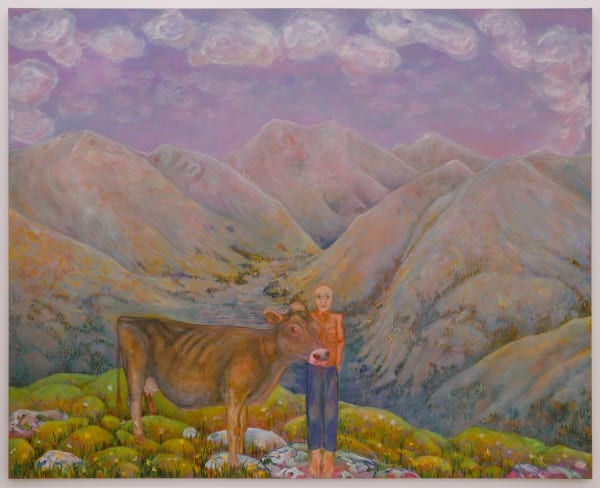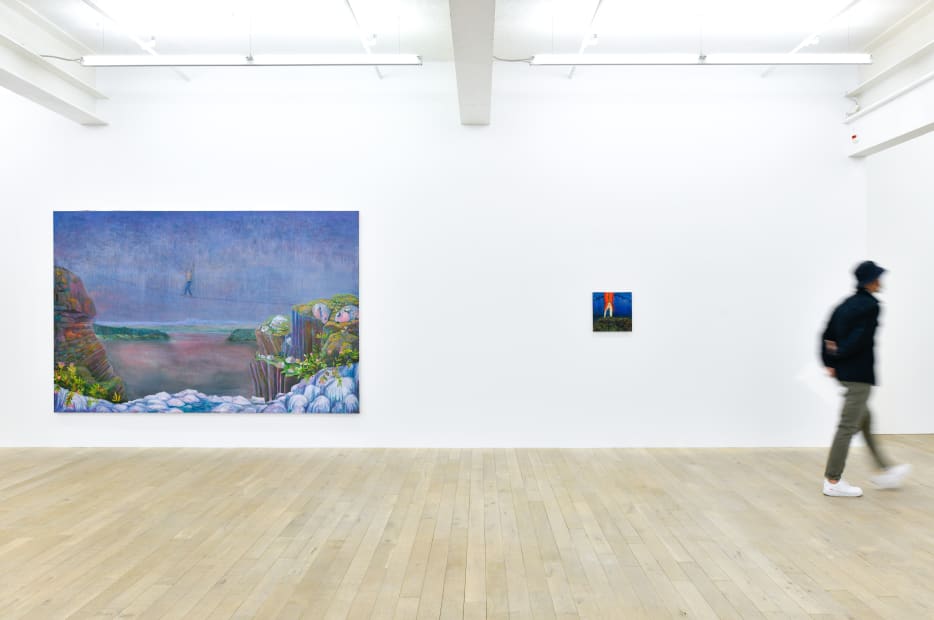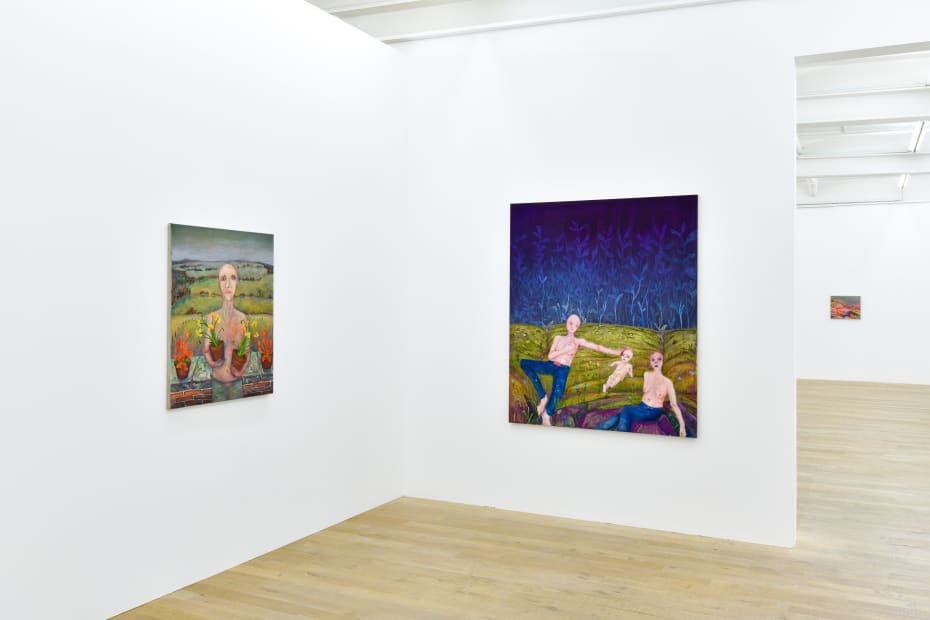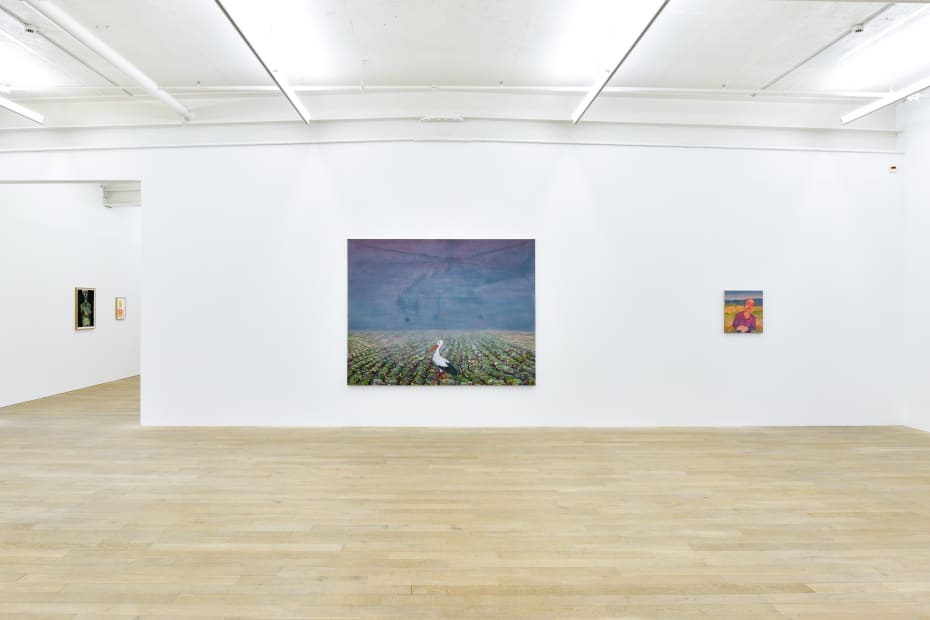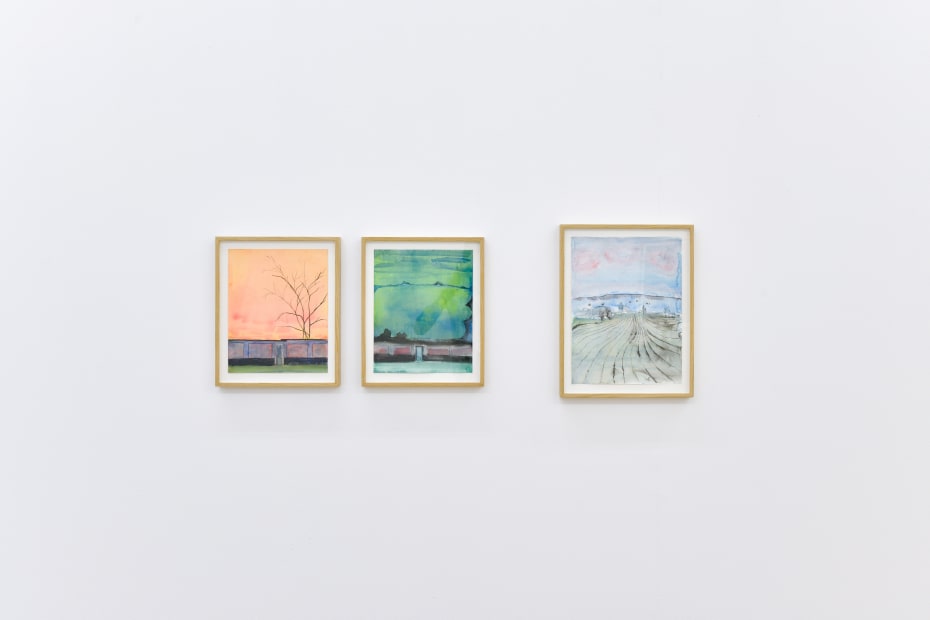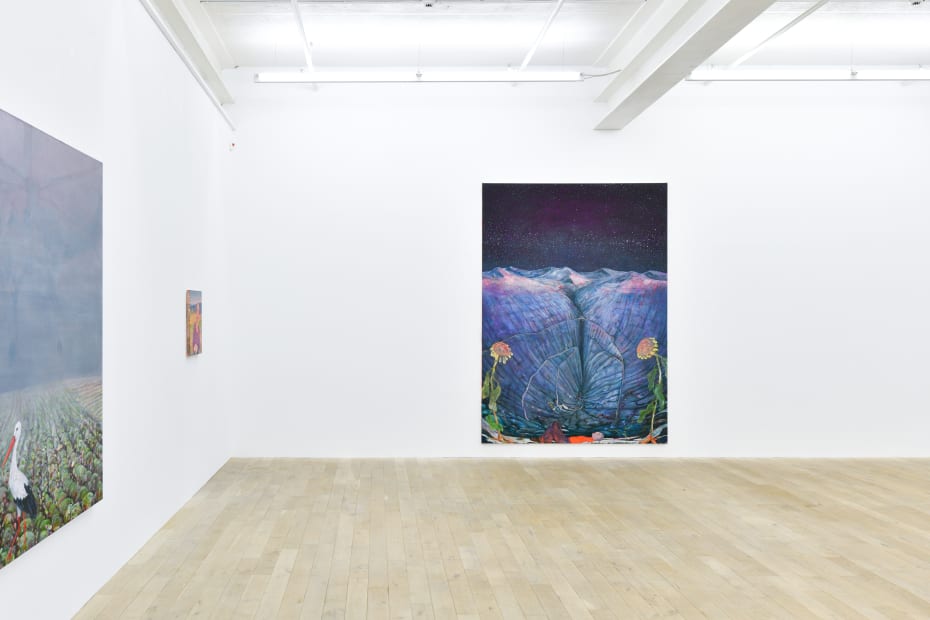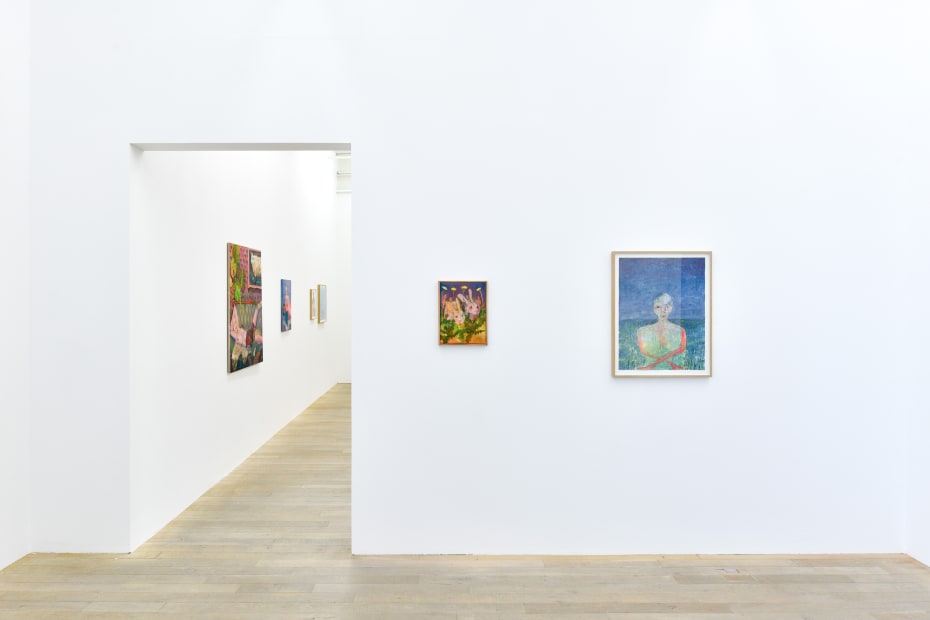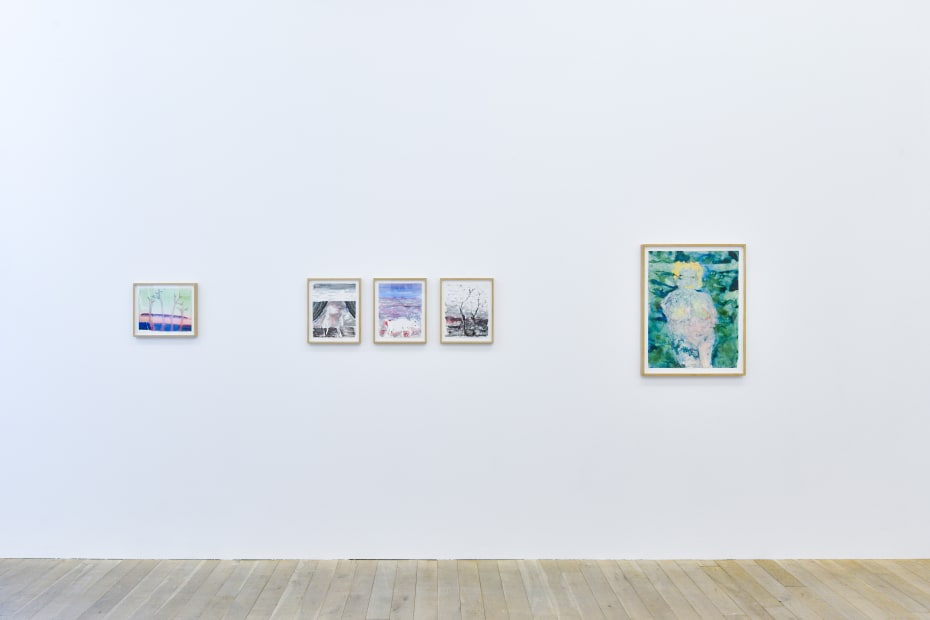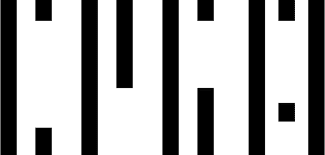Körper in diffusem Licht is Deplazes second exhibition at the gallery. The paintings of the artist, who is only 28 years old, already show great maturity and stylistic confidence. Established styles, such as the parallelism and symbolism by Ferdinand Hodler or the rebellious aesthetics of Pierre Bonnard and Les Nabis, are translated into a contemporary visual language with a pronounced irony.
The subject of the exhibition are new series of paintings that examine the role of humankind in nature and within its social fabric on a philosophical-anthropological level. Alongside familiar subjects from earlier works, such as the vastness of the landscape and the physicality of man, there are new architectural elements and the domestic interior. The presentation will extend across all rooms of the gallery and include several paintings in large, medium and small format as well as a body of new works on paper.
At first glance, the large-scale compositions by Andriu Deplazes seem to be located in an alien world, far from our real lives and current events. Strangely alienated figures, vast plains or lush vegetation come together in an indefinable moment that has neither beginning nor end. Nevertheless, there is something hidden there that inspires us to draw immediate references to our own living space. Thus, the paintings speak of the artist's far-reaching interest in culturally shaped identities in their living space. Based on this interest, Körper in diffusem Licht combines in three new groups of works the themes of humanity and nature with questions about the concept of family and the interior as an intimate space.
Closely interwoven with the title of the exhibition is the monumental work Slackliner (308 x 207 cm, see invitation card). It shows a landscape of perspectival depth that oscillates between realism and poetic fiction. The view wanders from a rocky plateau across the expanse of a lake. A bluish mountain range fades in the diffuse light of the horizon. A narrow rope is stretched between two mossy rocky outcrops, on the middle of which a male figure is balancing. The brushstroke changes from soft areas of flowing colour to restless hatchings that create the illusion of haptic coldness in the monochrome blue of the sky. The dense atmosphere seems to swallow the tightrope walker. Thoughts of wild forces of nature mingle with the overwhelming longing for harmony with nature familiar from the works of Romantic masters such as Caspar David Friedrich. Deplazes translates this approach into a here and now in which glaciers are melting and nature is at its limit. The timeless desire to return to the origins seems stronger than ever and leads people to go to their extreme in nature through extreme sports and outdoor mania.
The loneliness and vastness of the landscape also play a central role in works such as Sechs Augen im Horizont (Six eyes in the horizon, 168 x 224 cm) and Fünf Körper und gelbrötliches Licht (Five bodies and yellow-red light, 160 x 190 cm). But here, the figures and their interpersonal relationship come more to the fore. Despite their togetherness, the two protagonists in Sechs Augen im Horizont seem completely absorbed in the contemplation of themselves. In Fünf Körper und gelbrötliches Licht, it remains uncommented in which constellation the depicted group has come together. The idyll inherent in the sunset is interrupted by uncanny surrealism. In their constellation and colourfulness, the scenes are reminiscent of photographs by Sharon Lockhart as well as paintings by Pierre Bonnard and inspire us to reflect on our own function and the feeling of being a stranger in the community.
The question of belonging and socially formed norm is further explored in works centred around the family. Representative of the ambivalent role of mother and father, which is increasingly shifting in today's society, can be read in the works Körper mit Babys auf Treppe (Body with babies on stairs) and Zwei Körper auf Treppe (Two bodies on stairs, each 190 x 140 cm). At the centre of each is a naked group of figures on a staircase that loses itself into the unknown. In Körper mit Babys auf Treppe, a rather male-looking figure strides down the steps, carrying two babies in his arms. In Zwei Körper auf Treppe, the adult figure can be identified as rather female by her soft forms. On her left, she holds a small child by the hand. Lush, deep red blossoms and dense, night-green tendrils of blue rain evoke the idea of a paradisiacal, protective garden. Yet there is also something guarding about the situation: as mother and child walk up the stairs, their heads are grotesquely turned to their backs, fixing us with an inscrutable gaze. Although we are observing, we feel observed and are asked not to judge the observed constellation according to a subjective scheme.
In works such as Körper am Tisch (Body at the table, 194 x 248 cm), the family constellation is transferred to the domestic interior. Every family member and every object seems to have found its place here. The plants are symmetrically arranged and the animals domesticated. The situation leaves it uncommented what or who the depicted figures are waiting for. It could be the head of the family or the evening meal. Behind the harmonious façade lies something hidden. A desire to break out that makes the fish in the aquarium gasp for air. The figures look out of the picture and seem to question us. It is a look that unsettles us as viewers and inspires us to question the classic family model.
A selection of paintings and drawings on paper take up individual subjects of the paintings and enliven them with a spontaneous lightness. Through the quick brushwork, which is particularly characteristic of ink drawing, the forms and portraits become more expressive and intuitive. The selected motifs are an important component of the respective group of works and show an alternative, much more playful approach to the subject matter of the paintings.
 Andriu DeplazesFünf Körper und gelb-rötliches Licht (Five bodies in red-yellow light), 2021Oil on canvas160 x 190 cm (63.0 x 74.8 in.)
Andriu DeplazesFünf Körper und gelb-rötliches Licht (Five bodies in red-yellow light), 2021Oil on canvas160 x 190 cm (63.0 x 74.8 in.) Andriu DeplazesSlackliner, 2021Oil on canvas207 x 315 cm (81.5 x 124.0 in.)
Andriu DeplazesSlackliner, 2021Oil on canvas207 x 315 cm (81.5 x 124.0 in.) Andriu DeplazesLicht kreuzt (Light crossing), 2021Oil on canvas160 x 200 cm (63.0 x 78.7 in.)
Andriu DeplazesLicht kreuzt (Light crossing), 2021Oil on canvas160 x 200 cm (63.0 x 78.7 in.) Andriu DeplazesKörper im Abgang (Body descending), 2021Oil on canvas190 x 140 cm (74.8 x 55.1 in.)
Andriu DeplazesKörper im Abgang (Body descending), 2021Oil on canvas190 x 140 cm (74.8 x 55.1 in.) Andriu DeplazesLiegen zwischen Sonnenblumen (Lying among sunflowers), 2021Oil on canvas263 x 187 cm (103.5 x 73.6 in.)
Andriu DeplazesLiegen zwischen Sonnenblumen (Lying among sunflowers), 2021Oil on canvas263 x 187 cm (103.5 x 73.6 in.) Andriu DeplazesKörper und Schwein sitzen (Body and pig sitting), 2021Oil on canvas59 x 43 cm (23.2 x 16.9 in.)
Andriu DeplazesKörper und Schwein sitzen (Body and pig sitting), 2021Oil on canvas59 x 43 cm (23.2 x 16.9 in.) Andriu DeplazesStorch vor Drohne in diffusem Licht (Stork in front of drone in scattered light), 2021Oil on canvas177 x 227 cm (69.7 x 89.4 in.)
Andriu DeplazesStorch vor Drohne in diffusem Licht (Stork in front of drone in scattered light), 2021Oil on canvas177 x 227 cm (69.7 x 89.4 in.) Andriu DeplazesKörper, Schaf und Kanapee (Body, sheep, and sofa), 2021Oil on canvas110 x 100 cm (43.3 x 39.4 in.)
Andriu DeplazesKörper, Schaf und Kanapee (Body, sheep, and sofa), 2021Oil on canvas110 x 100 cm (43.3 x 39.4 in.) Andriu DeplazesKörper und Kuh (Body and cow), 2021Oil on canvas196 x 243 cm (77.2 x 95.7 in.)
Andriu DeplazesKörper und Kuh (Body and cow), 2021Oil on canvas196 x 243 cm (77.2 x 95.7 in.)








